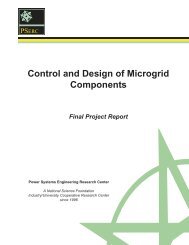Development and Evaluation of System Restoration Strategies from ...
Development and Evaluation of System Restoration Strategies from ...
Development and Evaluation of System Restoration Strategies from ...
You also want an ePaper? Increase the reach of your titles
YUMPU automatically turns print PDFs into web optimized ePapers that Google loves.
Part IV. Automated Optimal Transmission <strong>System</strong> <strong>Restoration</strong><br />
(work done at Washington State University <strong>and</strong> University <strong>of</strong> Tennessee)<br />
Transmission system restoration is critical to the integrated power system restoration<br />
process. It builds the transmission line skeleton to facilitate the restoration <strong>of</strong> generation<br />
<strong>and</strong> the distribution system. Generation units rely on this skeleton to pick up appropriate<br />
amount <strong>of</strong> loads to maintain a viable balance during restoration. Distribution substations<br />
rely on this skeleton to restore lost loads. The corresponding optimization problem is <strong>of</strong><br />
combinatorial nature. The restoration algorithms assist system operators during<br />
restoration by determining the order <strong>and</strong> time at which transmission lines should be<br />
energized.<br />
The optimal transmission path search is formulated into a Mixed Integer Quadratically<br />
Constrained Programming (MIQCP) problem under the assumption that the transmission<br />
network is lossless. Since the quadratic terms in the MIQCP problem are all pseudo (i.e.,<br />
they are multiplication between a binary variable <strong>and</strong> a real number), a general rule is<br />
derived <strong>and</strong> proved to linearize these pseudo-quadratic terms. With the linearization <strong>of</strong><br />
these pseudo-quadratic constraints, the MIQCP problem is converted to a Mixed Integer<br />
Linear Programming (MILP) problem. With the assistance <strong>of</strong> other more detailed<br />
analysis programs, the feasibility <strong>of</strong> a transmission line restoration plan can be checked.<br />
Any necessary adjustments can then be performed to satisfy all system constraints, static<br />
or dynamic.<br />
The main contributions <strong>of</strong> this research are:<br />
• Novel approaches for determining proper transmission system restoration strategies.<br />
• Formulation <strong>of</strong> the optimal transmission path search as an MILP problem.<br />
• Formulation <strong>and</strong> pro<strong>of</strong> <strong>of</strong> a st<strong>and</strong>ard rule to linearize a pseudo-quadratic term.<br />
This work constitutes an extension to transmission system restoration that was described<br />
in Part II. The viability <strong>of</strong> this approach was demonstrated on a 6-bus system.<br />
v
















